
Spain is not a holiday destination for me, but at the time of writing this I am living
here. So during this one year period I visited several places that I would like to
show you.
El Escorial
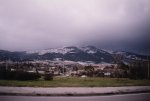 El Escorial and San Lorenzo de El Escorial in wintertime. The mountain behind it is
called Abantos (1753 m.) and is part of the Sierra de Guadarrarama. This is where I lived
for 15 months.
El Escorial and San Lorenzo de El Escorial in wintertime. The mountain behind it is
called Abantos (1753 m.) and is part of the Sierra de Guadarrarama. This is where I lived
for 15 months.
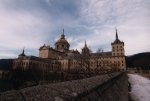 The monastery of San Lorenzo de El Escorial. Build between 1563 and 1584 build by Philip II.
Here you will also find the royal mausoleum. This is definitely a place worth visiting.
The monastery of San Lorenzo de El Escorial. Build between 1563 and 1584 build by Philip II.
Here you will also find the royal mausoleum. This is definitely a place worth visiting.
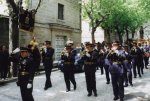
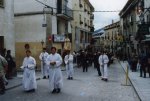 Semana Santa (Holy Easter week).
Semana Santa (Holy Easter week).
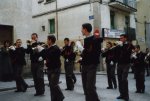
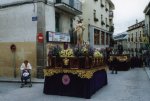 Semana Santa.
Semana Santa.
Avila
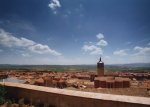 At an altitude of 1131 m lies Avila de los Caballeros (Avila of the knights), the highest
province capital of Spain.
At an altitude of 1131 m lies Avila de los Caballeros (Avila of the knights), the highest
province capital of Spain.
A lot of churches and monasteries in Avila have something to do with the Holy Teresa.
Teresa de Cepeda y Ahumada (1515-1582) was one of the greatest reformers in catholic
history.
 The most remarkable thing about this place are the citywalls.
Build in the 11th century they are one of the best preserved walls from the Middle Ages
in Europe. The total length is more than 2 km and they contain 88 towers.
The most remarkable thing about this place are the citywalls.
Build in the 11th century they are one of the best preserved walls from the Middle Ages
in Europe. The total length is more than 2 km and they contain 88 towers.
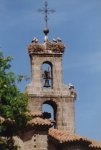 You can find a lot of storks at Avila. In spring they
build their nests on the towers of the citywall and also on the roofs of churches.
You can find a lot of storks at Avila. In spring they
build their nests on the towers of the citywall and also on the roofs of churches.
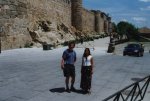 Andy and Janine in Avila.
Andy and Janine in Avila.
Segovia
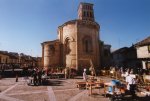 Festival of the pig. My collegue Andy and I arrived at Segovia and found ourselves in
a fiesta with free food and wine. A very nice way to explore a city.
Festival of the pig. My collegue Andy and I arrived at Segovia and found ourselves in
a fiesta with free food and wine. A very nice way to explore a city.
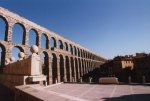
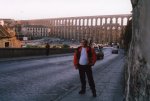 The aquaduct, build by Romans in the first century was still being used until the end of the
19th century. The Romans called the city Segobriga in those days. The total length is 728 m.
and is 29 m. high.
The aquaduct, build by Romans in the first century was still being used until the end of the
19th century. The Romans called the city Segobriga in those days. The total length is 728 m.
and is 29 m. high.
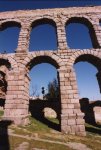 Detail of the aquaduct. Because the surface is very steep in some places they had to build
two layers of arches. All the way at the top the aquaduct contains the canal that
transported water from the Rio Frio to the city. Before it reached the city a few reservoirs
filtered the water.
Detail of the aquaduct. Because the surface is very steep in some places they had to build
two layers of arches. All the way at the top the aquaduct contains the canal that
transported water from the Rio Frio to the city. Before it reached the city a few reservoirs
filtered the water.
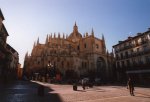
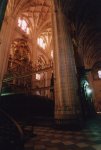 The gothic cathedral of Segovia. Build in 1525 it was finished in 1678. It is the youngest
great gothic churches in Spain. It replaced the old one that was destroyed in 1520 during
a revolt in several Castillian cities. It looks very impressive and also the inside is
worth visiting. Be aware of gipsies in the front of the church who are selling table
cloths. They won't take no for an answer. If you are interested in bying one, don't show
any interest. The price will go down very fast, probably a factor of 5 lower then their
first bid.
The gothic cathedral of Segovia. Build in 1525 it was finished in 1678. It is the youngest
great gothic churches in Spain. It replaced the old one that was destroyed in 1520 during
a revolt in several Castillian cities. It looks very impressive and also the inside is
worth visiting. Be aware of gipsies in the front of the church who are selling table
cloths. They won't take no for an answer. If you are interested in bying one, don't show
any interest. The price will go down very fast, probably a factor of 5 lower then their
first bid.
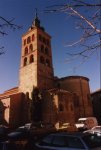 Church in Segovia. It is close to the Alcazar. I think it is called San Esteban.
Church in Segovia. It is close to the Alcazar. I think it is called San Esteban.
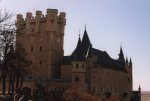 On the west side of Segovia you can find the Alcazar. It looks a bit like a castle from
a fairy tale. The fortess from the middle ages was burnt down in 1862. The current building
is a reconstruction of the original castle. It used to be a royal palace.
On the west side of Segovia you can find the Alcazar. It looks a bit like a castle from
a fairy tale. The fortess from the middle ages was burnt down in 1862. The current building
is a reconstruction of the original castle. It used to be a royal palace.
Madrid
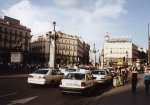 Puerta del Sol is part of the old city of Madrid. It is a very busy place where you can
find lots of stores. You can also find the roadmark for 'kilometer 0', the origin of
many roads starting in Madrid. Once there was the old gate to enter the city on the
east side.
Puerta del Sol is part of the old city of Madrid. It is a very busy place where you can
find lots of stores. You can also find the roadmark for 'kilometer 0', the origin of
many roads starting in Madrid. Once there was the old gate to enter the city on the
east side.
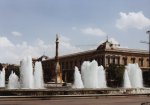 Plaza del Colon with a monument of Columbus.
Plaza del Colon with a monument of Columbus.
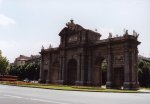 Puerta de Alcala at the Plaza de la Independencia. This is at the north west side of the
Parque de Retiro.
Puerta de Alcala at the Plaza de la Independencia. This is at the north west side of the
Parque de Retiro.
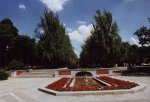
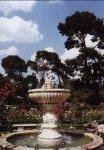 The picture on the left shows the entrance of the Parque del Retiro. This is a very
old park that used to be part of a royal palace. Now only the Cason del Buen
Retiro and the Museo del Ejercitio are left.
Picture on the right shows a fountain in the Parque the Retiro.
The picture on the left shows the entrance of the Parque del Retiro. This is a very
old park that used to be part of a royal palace. Now only the Cason del Buen
Retiro and the Museo del Ejercitio are left.
Picture on the right shows a fountain in the Parque the Retiro.
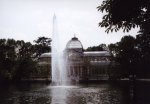
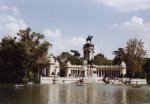 The Palacio de Cristal on the left and on the right a monument for Alfonso XII (1901)
at the lake in the park.
The Palacio de Cristal on the left and on the right a monument for Alfonso XII (1901)
at the lake in the park.
Sierra de Guadarrama
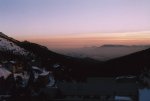 Sunset over the Sierra de Guadarrama. This picture is taken near Puerto de Navacerrada
in wintertime at an altitude of 1800 m.
Sunset over the Sierra de Guadarrama. This picture is taken near Puerto de Navacerrada
in wintertime at an altitude of 1800 m.
Sierra de Gredos
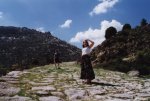 Janine and Andy on the Roman Road in the Sierra de Gredos.
Janine and Andy on the Roman Road in the Sierra de Gredos.
La Rioja
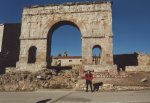
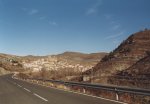
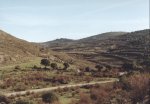
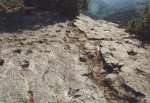
During a weekend I went with my collegue Alberto to La Rioja in the northern part
of Spain to search for dinosaur tracks. Near Enciso we did find them.
The first picture is taken in Medinaceli where you can find roman architecture. Then
you see the landscape near Enciso and finally the dinasaur tracks.
This document was last updated on 06/04/01


![]()
![]() The Palacio de Cristal on the left and on the right a monument for Alfonso XII (1901)
at the lake in the park.
The Palacio de Cristal on the left and on the right a monument for Alfonso XII (1901)
at the lake in the park.